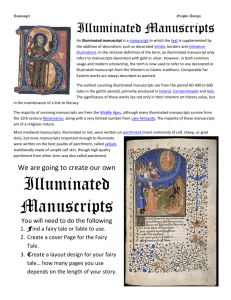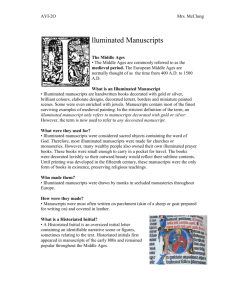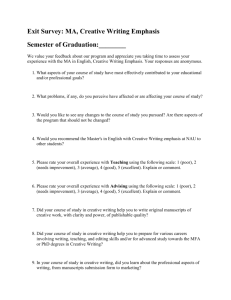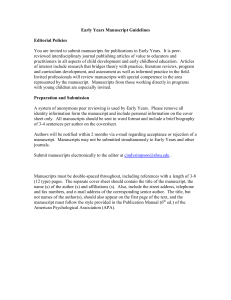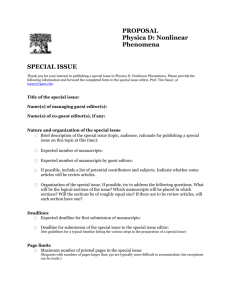Looking at early printing
advertisement
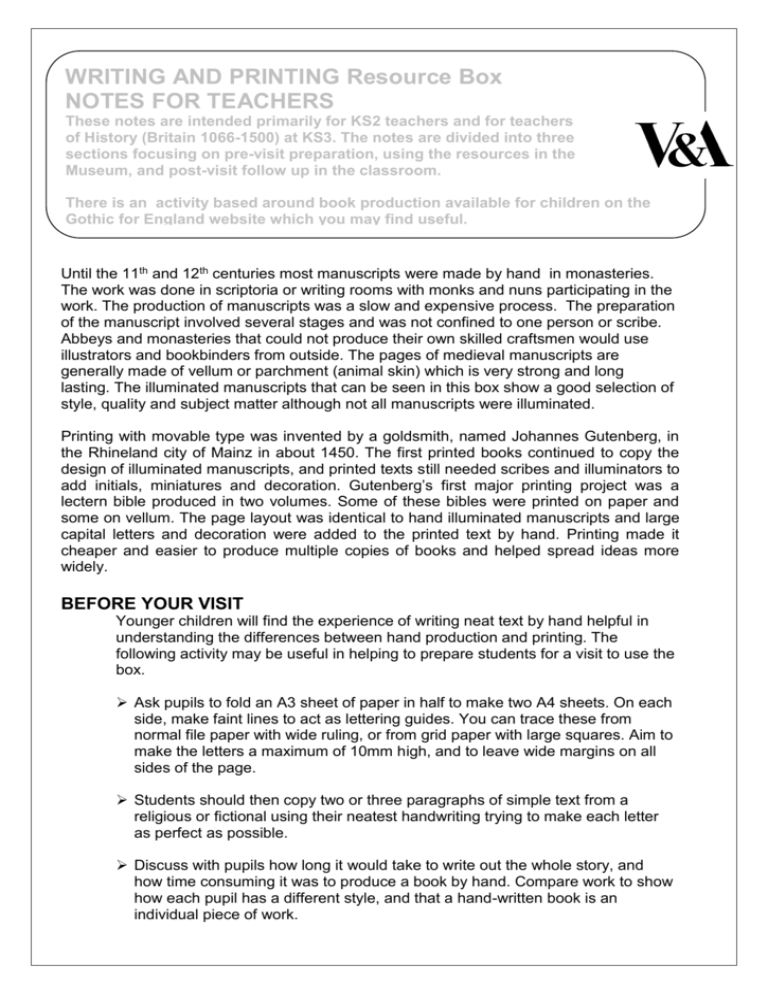
WRITING AND PRINTING Resource Box NOTES FOR TEACHERS These notes are intended primarily for KS2 teachers and for teachers of History (Britain 1066-1500) at KS3. The notes are divided into three sections focusing on pre-visit preparation, using the resources in the Museum, and post-visit follow up in the classroom. There is an activity based around book production available for children on the Gothic for England website which you may find useful. Until the 11th and 12th centuries most manuscripts were made by hand in monasteries. The work was done in scriptoria or writing rooms with monks and nuns participating in the work. The production of manuscripts was a slow and expensive process. The preparation of the manuscript involved several stages and was not confined to one person or scribe. Abbeys and monasteries that could not produce their own skilled craftsmen would use illustrators and bookbinders from outside. The pages of medieval manuscripts are generally made of vellum or parchment (animal skin) which is very strong and long lasting. The illuminated manuscripts that can be seen in this box show a good selection of style, quality and subject matter although not all manuscripts were illuminated. Printing with movable type was invented by a goldsmith, named Johannes Gutenberg, in the Rhineland city of Mainz in about 1450. The first printed books continued to copy the design of illuminated manuscripts, and printed texts still needed scribes and illuminators to add initials, miniatures and decoration. Gutenberg’s first major printing project was a lectern bible produced in two volumes. Some of these bibles were printed on paper and some on vellum. The page layout was identical to hand illuminated manuscripts and large capital letters and decoration were added to the printed text by hand. Printing made it cheaper and easier to produce multiple copies of books and helped spread ideas more widely. BEFORE YOUR VISIT Younger children will find the experience of writing neat text by hand helpful in understanding the differences between hand production and printing. The following activity may be useful in helping to prepare students for a visit to use the box. Ask pupils to fold an A3 sheet of paper in half to make two A4 sheets. On each side, make faint lines to act as lettering guides. You can trace these from normal file paper with wide ruling, or from grid paper with large squares. Aim to make the letters a maximum of 10mm high, and to leave wide margins on all sides of the page. Students should then copy two or three paragraphs of simple text from a religious or fictional using their neatest handwriting trying to make each letter as perfect as possible. Discuss with pupils how long it would take to write out the whole story, and how time consuming it was to produce a book by hand. Compare work to show how each pupil has a different style, and that a hand-written book is an individual piece of work. Ask students to check each other's work for errors. Discuss possible ways of correcting mistakes, such as rubbers and correcting fluid and whether these would have been available in the thirteenth century. Someone would have been responsible for checking the manuscript for mistakes. Look at the spine of a bound book. Point out how the pages are in folded sections, which are joined at the spine. Using pupils' folded pages as an example, show that the folded double pages would have been stitched together along the fold. The pages they will be examining in the Print Room are one half of a folded leaf from a manuscript. Though many complete manuscripts have survived, individual leaves continue to be highly valued, mainly for their decoration. IN THE PRINT ROOM Looking at illuminated manuscripts Students will find it most useful to look closely and note small details. Most of the examples are in Latin rather English, but obviously pupils do not to be able to understand the writing. Ask students to see how many of the following points they can observe from a sample of manuscripts. Hand production The manuscripts provide many clues that they were produced by hand. Children should look for: Faint ruled lines that acted as lettering guides, as well as lines for columns. Ghost marks where drawings have been altered or moved. These lines and marks were either drawn in lead, or scratched using a stylus The words and sentences are often spaced out to align the column to both the left and the right. If a word could not be fitted on to the line at the righthand side, a hyphen is used to break it; sometimes the word runs over or is condensed to make it fit into the line width. Mistakes were inevitable in a hand process. Small errors were scraped off the vellum and written over. You may find words or phrases that have been added above or below the line, or in the margin, Whole lines or paragraphs were sometimes added to the bottom of the page. Some manuscripts have additional notes or comments in the margins. Look closely at the vellum. It varies in thickness and roughness, sometimes from one part of the leaf to another. Some vellum leaves are wrinkled, others are smooth. A comparison of the paint and ink on several manuscripts will show that there is variation in density and shade. Expensive materials Vellum is high-quality parchment produced from calfskin, goatskin or sheepskin and was an expensive material. It does not soak up ink or paint, and so is good for fine detail, and colours do not fade quickly. Look for gold leaf and gold powder. These expensive materials were used sparingly, in the centre of an illuminated letter for example. Types of illumination Initial letters were decorated to make them stand out, and sometimes include a picture inside the letter shape. In certain religious texts, important days such as saints' days were denoted by a red letter starting the text, and this is the origin of the phrase 'red letter day'. Miniature pictures are sometimes there to illustrate the narrative, and sometimes simply to decorate the page. Ask students to draw examples of the types of illumination such as decorated letters, borders and pictures that they can see on the manuscripts. Look for drawings of people, animals, trees, countryside, plants, buildings, interiors or even fantasy creatures. Holy people are sometimes shown wearing haloes. The size of miniatures varies from small pictures inside initials to full-page illustrations without text. As more ornate styles developed, the borders separating the miniatures from the text were extended down the margins and around the page. Apart from gold leaf, pupils should note the colours they can find. Red and blue are commonly used colours, but yellow, green and pink were also used. Some letters and illustration have touches of shadow, giving a 3D effect. The process of production. By the thirteenth century the skilled scribes who produced the text worked either in monasteries or as professionals in outside workshops. The guild apprenticeship to become a scribe took about seven years. Although some scribes did compose, text was generally copied from another manuscript. From workshop ledgers and letters from monasteries we know that scribes could write about four large leaves a day. An illuminated manuscript was the work of a number of skilled craftsmen. The text was written first by one or more scribes, with spaces left for initials and illustration. The sheets were then passed to an illustrator, who would outline the borders and the illuminated letters. Details were added with pen and ink, sometimes using compasses, ruler and set square. Colour outlines were also done by pen, with the final infilling completed with a fine brush. Ask pupils to find evidence of the high level of skill that went into the production of illuminated manuscripts. They should note that the illuminations are very detailed and precise. Pupils should also compare the same letter in different parts of the text. They are likely to find very little variation, even though written by hand. From their own experience of handwriting they will appreciate just how much practice was needed. Some workshops divided labour into the specialist skills of preparing and cutting the vellum, and applying and burnishing the gold leaf. Subject matter and readership Most of the illuminated manuscripts that can be seen in the Print Room are religious texts. Many abbeys and monasteries would produce their own works but those that did not have their own skilled craftsmen would use illustrators and bookbinders from outside. By the end of the twelfth century the monopoly of the church over teaching and scholarship had weakened, and universities prospered. There was growing demand for texts to support administration and commerce, for scholarship and learning, and for an increasingly prosperous, urban, literate middle class. Lay workshops outside monasteries formed into guilds, and drafted official documents for the merchants. From the thirteenth century the number of new subjects grew to include mathematics, astronomy and philosophy, fiction, Greek and Roman classics, and even travel. Most manuscripts were still produced on commission as they were too expensive for a workshop to produce speculatively. The Prints, Drawings and Paintings Collection does not have as many examples of secular texts, such as legal and medical, as religious texts. Looking at early printing Though the technology of printing was developed around the 1450s onwards, the production of illuminated manuscripts did not cease immediately. Ask pupils to compare examples of early printing with illuminated manuscripts. The similarity between printed leaves and manuscript leaves can be seen in the page layout and the style of lettering. The illumination is just as detailed and colourful. Some workshops even printed on vellum in imitation of handproduced texts. This is not surprising. Printed texts arose as a quicker and cheaper way of meeting the demand for manuscripts and had to convince the buyers of expensive illuminated manuscripts that the new product was equal in quality. At first, only the text was printed, and spaces were left on the page for the illustrator to draw and colour the illumination. Later, woodblocked outlines were added to the spaces, but the colouring was still done by hand. Paper was introduced as a cheaper alternative to vellum. It was already manufactured in Europe, and was made from linen rags and sometimes hemp. Like vellum, the printed page was not always of uniform thickness, as making paper was also a hand process. Since printing was only economical if a substantial number of copies were made of each text, printers had to be fairly certain that their texts would sell. They therefore printed texts on subjects already in demand in manuscript, such as religious texts and scholarly texts for the growing universities. Looking at early books. It was not until the sixteenth century that printed books displaced illuminated manuscripts. From the printed leaves of this period pupils should be able to see that the smaller size of book would have been easier to handle. They should also note that the books were not necessarily illuminated, suggesting that an increased importance was placed on the text. If they were illustrated, they were certainly not hand-coloured. As literacy and scholarship became more widespread, printed books covered a broader range of subjects. Studies of herbs and plants, the explanations of different professions, atlases, maps and music scores were some of the printed books of the time. It was certainly cheaper to produce printed books than handmade illuminated manuscripts. However, printing needed substantial investment before production could take place, so the printing centres developed around major European commercial cities. Records show that workshops could print about 300 sheets per day. The handwriting of texts did not disappear altogether, as manuscripts continued to be commissioned if the number required was too small to justify printing costs. Manuscript was also used for prestigious texts, presentation scrolls or special prayer books. This tradition still continues today. BACK AT SCHOOL Discuss with students the processes of producing illuminated manuscripts and printed texts, and who they were made for. The following task will require pupils to demonstrate their understanding of the relative speed and expense of the two methods. Ask one group of students to imagine they are in charge of a manuscript workshop. They must write a letter to a wealthy local merchant explaining why the manuscript he has ordered is so expensive and will take so long to produce. In their letter they should outline all the different processes, the time taken, the expensive materials and the quality of the result. Another group should write to the same merchant from a new printing workshop explaining why the new printed texts are of comparable quality to hand-written manuscripts, and how they cut out many processes to bring the cost down. Students could use the writing they copied before their visit as the basis for own illuminated page. They could draw illuminated capital letters, possibly with an illustration inside, to stick over the hand-written ones. Pupils could emphasise the quality and value of their illuminated page by adding decorative borders based on the designs they saw in the Print Room. They could illustrate an important or dramatic part of the story. Their illustration should make the narrative easier to understand without the use of captions. Colour and gilt can be added in pen, paint or paper form. If students wish to produce fresh work, having seen a variety of examples, they might produce the pages of a school calendar marking important days with red letters or even illuminated capitals. The most ambitious might attempt an illuminated page of a story.

